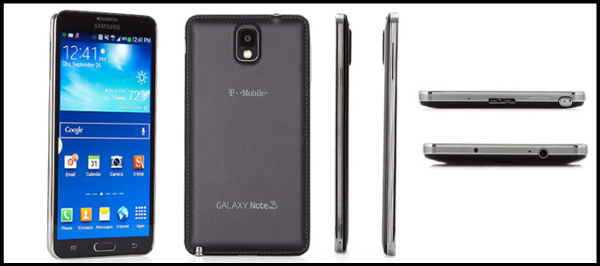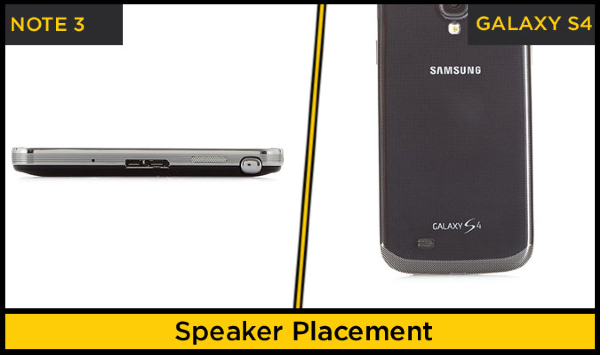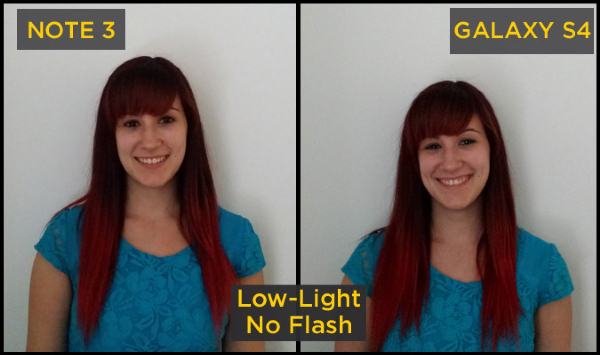Samsung Galaxy Note 3 vs. Galaxy S4: Face-Off!
We pit the Samsung Galaxy S4 against the Galaxy Note 3 in a nine-round showdown where only one smartphone survives. Here are the results.

Samsung’s Galaxy S4 and Galaxy Note 3 are two of the hottest smartphones on the planet. And though they come from the same company and offer similar features, there are a host of differences between the two handsets. The 5-inch, quad-core-powered S4 is meant to appeal to the widest range of users.
The Note 3, on the other hand, sports a much larger 5.7-inch display and is designed to take advantage of its built-in stylus and superpowered multitasking features. But only one of these smartphones can rule Samsung’s galaxy. We pitted the S4 and Note 3 against each other in an eight-round battle royale. Spoiler alert: It’s not even close.
Design
The Galaxy S4 uses a plastic design that’s light, but not very premium-looking. The back picks up fingerprints fairly quickly. The Note 3 is also made of plastic, but has a more refined look; it offers a faux leather rear panel meant to simulate a paper notebook, complete with a stitched leather aesthetic around the edge.

If you’re looking for a handset that will easily fit into one hand, the Galaxy Note 3 is not the phone for you. At 6.0 x 3.1 x 0.33 inches and 5.9 ounces, the Note 3 has quite a large footprint, but at least it’s lighter than competing phablets.

The Galaxy S4 measures 5.3 x 2.7 x 0.25 inches and weighs 4.6 ounces. That’s considerably smaller and lighter than the Note 3, making the S4 fairly easy to use with one hand. Both phones also feature removeable back panels, something we’re always happy to see on a smartphone.
Winner: Tie. The Galaxy Note 3 sports more sophisticated looks, while the Galaxy S4 offers a more compact, lightweight design, resulting in both handsets getting points for this round.
Display
The Galaxy Note 3’s 5.5-inch, 1920 x 1080 resolution Super AMOLED display looked absolutely gorgeous during our testing. Colors were warm and vibrant and appeared to pop off of the screen. Text and images looked especially sharp. The S4 also features a 1920 x 1080 resolution Super AMOLED display, albeit at a smaller 5 inches. Between the two, the Note 3 offered deeper blacks than the S4.

While watching a trailer for the film “Ender’s Game,” an image of the titular character looked just as colorful and sharp on the Note 3 as it did on the S4. But the size difference between the Note 3 and the S4, 0.5 inches, is great enough as to make viewing things on the Note 3’s display far wider than on the Galaxy S4’s. The larger text and images on the Note 3 meant we could hold it farther away from our faces than the S4 while watching a movie or reading an article.
The Note 3’s screen is also brighter than the S4. Using our light meter, Samsung’s phablet registered 539 lux, compared with 460 lux for the smaller Galaxy.
Winner: Galaxy Note 3. Samsung’s Galaxy Note 3 and Galaxy S4 may use the same display technology, but the Note 3’s larger and brighter screen makes for a better viewing experience.
Audio
The Galaxy Note 3’s external speaker is positioned on its bottom edge. By contrast, the Galaxy S4’s speaker sits on the bottom of its rear panel. Between the two phones, the Galaxy S4 provided the loudest audio, offering 73 decibels of sound, while the Note 3 came in at 71 dB.

Overall, audio sounded slightly better on the Galaxy S4, with the handset focusing more on higher notes. The Note 3 seemed to focus on lower, bass-heavy notes. While listening to TV on the Radio’s “Will Do,” bells and high-pitched guitar riffs rang out on the S4, though bass was a bit lacking. The opposite was true for the Note 3, with guitar riffs lacking and bass hits coming through clearly. In the end, neither handset provided particularly high- quality audio.
Winner: Draw. The Galaxy S4 is slightly louder, but the handsets are similarly mediocre otherwise when it comes to audio.
Interface and Software
The Galaxy Note 3 comes with Google’s Android 4.3 right out of the box. The Galaxy S4, meanwhile, includes Google’s older Android 4.2.2 OS (it should get Android 4.3 fairly soon). In truth, you won’t notice much of a difference between the two operating systems from a functionality standpoint, though 4.3 does allow for compatibility with Samsung’s Galaxy Gear smartwatch. Both smartphones also include Samsung’s Touchwiz overlay with its myriad quick settings and helpful notifications menu.

The Note 3 gets a few key features that the S4 doesn’t, namely the My Magazine app. Powered by Flipboard, My Magazine gives you a single destination to check out what’s happening in the news and your social circles. The app is broken down into four image-heavy pages, including News, Personal, Here and Now and Social.

Winner: Galaxy Note 3. The Galaxy Note 3 not only comes packing the newer version of Android Jelly Bean, it offers the slick My Magazine app.
Performance
The Galaxy Note 3 is a processing behemoth, packing a 2.3-GHz quad-core Qualcomm Snapdragon 800 processor and 3GB of RAM. The Galaxy S4 features Qualcomm’s last-generation Snapdragon 600 processor and 2GB of RAM. Both handsets proved snappy during everyday use, with neither showing noticeable signs of lag.
That kind of horsepower lets the Note 3 easily run the latest and most demanding Android games, including “N.O.V.A. 3” and “Riptide GP 2” with ease. The Note 3 also opened its Camera app a tick faster than the S4 (2.5 versus 3 seconds). We saw a larger differential when opening “N.O.V.A. 3,” with the Note 3 taking just 13 seconds and the S4 taking 15.
That said, we didn’t see any differences between the Note 3 and S4 when exiting apps to the home screen or changing screen orientation in the Web browser.
The Note 3 transcoded a 204MB, 1080p video file to 480p using the VidTrim app in just 5 minutes and 15 seconds. The S4 and its older processor took 7:25 to finish the test. Both handsets, however, beat out the smartphone category average of 8:26.

On the Quadrant benchmark, which tests a device’s overall performance, the Note 3 scored a sky-high 22,383, obliterating the Galaxy S4’s score of 12,251. The smartphone category average hit just 7,119.
Similarly, on the Geekbench 3 test, the Note 3 hit a monstrously high 2,979. This showing crushed the Galaxy S4’s score of 1,838.

The results were no different on the 3DMark Ice Storm Unlimited graphics test, with the Note 3 topping out at 18,808. The Galaxy S4 hit 10,393, while the average smartphone scored 9,446.
Winner: Galaxy Note 3. The Galaxy Note 3’s quad-core Snapdragon 800 processor and 3GB of RAM help it blow away both the Galaxy S4 and smartphone category averages across multiple tests.
Camera
The Galaxy Note 3 and Galaxy S4 both offer 13-megapixel rear shooters. And while Samsung representatives said the company doesn’t comment on specific camera sensor hardware, they did let slip that they may have different image sensors.
Despite that, the handsets offered incredibly similar images in both low light and normal shooting situations. A low-light photo of a young woman taken without flash with the Note 3 offered better focus than the S4, which captured a grainer image. Neither photo looked particularly good, though.

A photo of a flower looked colorful and sharp when taken with both the Galaxy Note 3 and S4, though colors were a bit more vibrant in the Note 3’s photo. Conversely, in an image of a busy intersection, the S4 offered slightly more vibrant colors than the Note 3. We noted the same kind of results across multiple images, with one phone’s shots looking better than the other’s by the slimmest of margins. In truth, you’d have to study photos taken with both handsets very closely to notice the difference.

Because of its Snapdragon 800 processor, the Note 3 can shoot 4K video while its little brother maxes out at 1080p. Also known as Ultra HD, 4K video is a sharp 3840 x 2160, more than double the pixels of full HD. There are already a number of high-end TVs that support the standard with less expensive models sure to come soon.
Winner: Galaxy Note 3. The 13-megapixel camera sensors on both the Galaxy Note 3 and Galaxy S4 produced similarly sharp and colorful images, but the Note 3’s 4K video capabilities put it over the top.
Special Features
All of the special features found on Samsung’s Galaxy S4, including the built-in IR blaster for controlling your TV, are present and accounted for on the Galaxy Note 3. The Galaxy Note 3, however, ups the ante with Samsung’s S Pen and its myriad functions. For its third-gweneration Note, Samsung offers a new Air Command app, which gives users access to five different utilities: Action Memo, Scrapbooker, Screen Write, S Finder and Pen Window.

Action Memo lets you create a digital Post-it note that lets you write quick memos, such as phone numbers or street addresses, and lets you quickly save them to your Contact list, dial them or look them up on Google Maps. Scrapbooker allows you to circle any information you see on your phone’s screen and save it for later use. Not only does it pull in things like addresses, but it makes them actionable, as well. Better still, the tool will copy metadata from whatever you copied, so you can visit the website you got it from without having to search for it again.
The Screen Write utility simply lets you take a screenshot and write on it. S Finder is a universal search that scours your emails, videos you’ve watched, Web pages you’ve gone to and more. Pen Window is perhaps the coolest of the Air Command tools, allowing you to sketch a window in which you can run an app on your Note 3’s display.
Winner: Galaxy Note 3. The Galaxy Note 3 offers all of the features found on the Galaxy S4, but ups the ante with its S Pen and Air Command utilities.
Battery Life
The Galaxy Note 3 is an endurance champ, thanks to its 3,200 mAh battery. A T-Mobile version of the handset lasted a marathon 11 hours and 15 minutes on our LAPTOP Battery Test, which includes continuous Web surfing over 4G LTE with the display set to 40 percent brightness. The Verizon version lasted nearly 10 hours.

The Galaxy S4’s smaller 2,600 mAh battery lasted 6:41 on T-Mobile’s network before calling it quits. That’s more than 4 hours short of the Note 3’s time. If you’re looking for incredible battery life, the choice is clear. The Verizon version lasted 5:25.
Winner: Galaxy Note 3. The Galaxy Note 3’s awesome battery life will get you through the entire workday and then some without ever having to search for an outlet.
Value
The Galaxy S4 is available through AT&T and Verizon for $199. Sprint users can pick up the phone for $99.99. If you’re a T-Mobile customer, the S4 will cost $49.99 up front and 24 equal monthly payments of $22.
The larger Galaxy Note 3 costs $299 on AT&T and Verizon and $249 on Sprint. T-Mobile users will pay $179 up front and 24 equal monthly payments of $21.
Winner: Galaxy S4. The Galaxy S4 easily beats the Note 3 in the value category thanks to its much lower cost on the Big Four carriers.
Overall Winner: Galaxy Note 3

Samsung’s $199 Galaxy S4 and $299 Galaxy Note 3 are both top-notch handsets that offer boatloads of features. However, the only two things the Galaxy S4 have going for it over the Note 4 are its lower price and more compact design. Otherwise, the Galaxy Note 3 is the hands-down winner. Speaking of hands, you’ll need two to handle this phablet, but the Galaxy Note 3’s more than justifies its larger size with its faster performance, much longer battery life and enhanced S Pen.

As a result, the Note 3 ran away with this face-off, taking 6 of 9 rounds and tying the S4 in 2, while the S4 took just 1 outright. The Note 3 is easily the best smartphone Samsung has ever made, making it the ruler of the Galaxy.
Follow Daniel Howley @DanielHowley and on Google+. Follow us @tomsguide, on Facebook and on Google+.
Sign up to get the BEST of Tom's Guide direct to your inbox.
Get instant access to breaking news, the hottest reviews, great deals and helpful tips.
Dan Howley is a writer and editor whose work has appeared on Tom's Guide, Laptop Mag, CNN business, MSN, AOL, and more, covering smartphones, laptops, and wearables. He now works full time at Yahoo Finance, where he writes articles covering the tech and gaming industries. He lives in New York.
